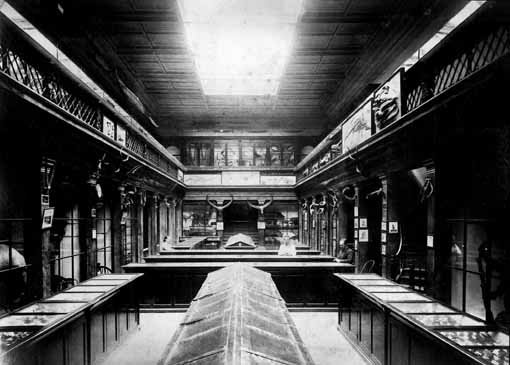Turning on the lights at the Australian Museum
Today the museum visitors’ experience is subtly enhanced by gallery lighting whilst unbeknownst to many, great care is taken to protect the objects and specimens from the harmful effects of the artificial lighting,

© Australian Museum
Early Australian Museum lighting was predominantly natural light enhanced by gas and oil lamps, candles and fire places. The sunlight steaming into and lighting the Museum is clearly seen in the photograph below. Apart from the location of the fireplaces little is known about the configuration of the Museum’s early artificial lights.

© Australian Museum
In 1904, amongst excitement and fear electric lights were turned on in Sydney. Not only was Sydney slow to adopt electricity but once connected residents and institutions were reluctant embracers of the new technology.
The Australian Museum was no different. The Museum’s first gallery, the Long Gallery, relied upon natural light streaming through the skylight and windows though this was compromised as there were no northern or western facing windows. In an era when displays were crowded one can only imagine how visitors had to squint to decipher the handwritten labels and appreciate the fine details of the objects. In subsequent 19th century Museum gallery additions expansive skylight roofs and numerous tall windows continued to provide most of the light.
In a move to allow more visitors to the Museum the Trustees in 1878 considered increasing the Museum’s opening hours to 10pm. However the Curator, with words that echo down the years, “reported that artificial light would be very injurious, if not destructive, to the specimens, and for that reason, as well as on the ground of expense, the proposal was held to be inadmissible”.
This reliance upon the sun must have been behind the Trustees decision in the early 1880’s to publicise winter and summer opening hours. In the days of longer, brighter sunshine visitors could marvel at the array of specimens until 6pm whereas in winter the Museum closed at 5pm.
In a clearly impractical but optimistic moment the Trustees, in October 1913, requested an estimate for the complete lighting of the Museum though by April the following year they resolved not to proceed. It was too expensive and too difficult. Eventually electricity was connected. In 1922 electric lights were finally switched on in the Museum.
Early electric lights though weak by today’s standards were relatively very bright when compared to the previous forms of lighting. It is no surprise that the first areas to have electric lights was the darkest public space, the Paleontological Gallery (ground floor) along with the staff’s work and residential areas. Given the impracticability of lighting whole galleries lights were initially built into display cases and suspended from low roofs with the later introduction of targeted spotlights; all placed to enhance the natural lights. The process of lighting the Museum was hampered by the difficulties workers experienced wiring the building and installing connections.
When the artificial lighting in a gallery achieved adequate standards the windows were bricked over and eventually the skylights were removed. In an ironic twist these changes in the Long Gallery triggered ventilation problems, resulting in high humidity readings which took many years to resolve.
The construction of the new Parkes-Farmer Wing galleries with no windows did not go unnoticed. In 1962 Museum Director, Dr Evans explained “The reason for this lack [of windows] is that most effective museum display is achieved with the aid of artificial light”. Since then no gallery space has been built with an external window.
Little is known about what became of the pre-electric lights though kerosene ‘Exit’ lamps survive in the museum’s archive collection and the Trust Minutes record, in March 1949, Mrs Maidment asked to buy one of the old gas lamps.
Today when the Museum closes and the visitors leave the lights are turned off and the galleries slide into quiet darkness except on the nights when the Museum echoes with the delightful squeals of children sleeping over.












